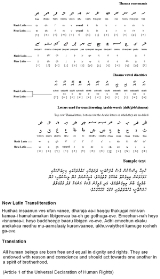
Dhivehi Writing Systems
Encyclopedia
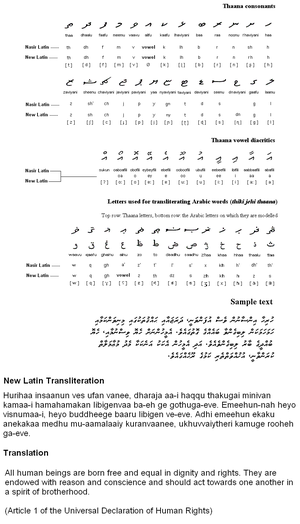
Dhivehi language
Maldivian is an Indo-Aryan language predominantly spoken by about 350,000 people in the Maldives where it is the national language. It is also the first language of nearly 10,000 people in the island of Minicoy in the Union territory of Lakshadweep, India where the Mahl dialect of the Maldivian...
or Divehi writing systems are the different scripts used by Maldivians during their history
History of the Maldives
The Maldives is a nation consisting of 26 natural atolls, comprising 1192 islands-Historical setting:Since very ancient times, the Maldives were ruled by kings and occasionally queens ....
. The early Maldivian scripts fell into the abugida
Abugida
An abugida , also called an alphasyllabary, is a segmental writing system in which consonant–vowel sequences are written as a unit: each unit is based on a consonant letter, and vowel notation is obligatory but secondary...
category, while the more recent Taana has characteristics of both an abugida and a true alphabet. An ancient form of Nagari script
Nagari script
The Nāgarī script is the ancestor of Devanagari, Assamese, Bengali and other variants, and was first used to write Prakrit and Sanskrit. It was in vogue from before the 10th century...
, as well as the Arabic and Latin alphabets have also been extensively used in the Maldives, but with a more restricted function. "Latin" was official only during a very brief period of the Islands' history.
The language of the Maldives
Maldives
The Maldives , , officially Republic of Maldives , also referred to as the Maldive Islands, is an island nation in the Indian Ocean formed by a double chain of twenty-six atolls oriented north-south off India's Lakshadweep islands, between Minicoy Island and...
has had its very own script since very ancient times. It is likely that the first Maldivian script appeared in association with the expansion of Buddhism throughout South Asia. This was over two millennia ago, in the Mauryan period, during emperor Ashoka
Ashoka
Ashok Maurya or Ashoka , popularly known as Ashoka the Great, was an Indian emperor of the Maurya Dynasty who ruled almost all of the Indian subcontinent from ca. 269 BC to 232 BC. One of India's greatest emperors, Ashoka reigned over most of present-day India after a number of military conquests...
's time. Manuscripts used by Maldivian Buddhist monks were probably written in a script that slowly evolved into a characteristic Maldivian form. Unfortunately none of those ancient documents have survived and presently the early forms of the Maldive script are only found etched on a few coral rocks and copper plates.
Ancient scripts (Evēla Akuru)
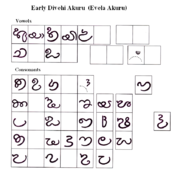
Brāhmī script
Brāhmī is the modern name given to the oldest members of the Brahmic family of scripts. The best-known Brāhmī inscriptions are the rock-cut edicts of Ashoka in north-central India, dated to the 3rd century BCE. These are traditionally considered to be early known examples of Brāhmī writing...
script and thus was written from left to right.
Divehi Akuru was separated into two variants, a more recent and an ancient one and christened “Dives Akuru” and "Evēla Akuru" respectively by Harry Charles Purvis Bell
Harry Charles Purvis Bell
Harry Charles Purvis Bell , more often known as HCP Bell, was a British civil servant, a commissioner in the Ceylon Civil Service. Appointed an official archaeologist, he carried out many excavations in Ceylon , for the Archaeological Survey, during an appointment running from 1890 to 1912After...
in the early 20th century. Bell was British
United Kingdom
The United Kingdom of Great Britain and Northern IrelandIn the United Kingdom and Dependencies, other languages have been officially recognised as legitimate autochthonous languages under the European Charter for Regional or Minority Languages...
and studied Maldivian epigraphy
Epigraphy
Epigraphy Epigraphy Epigraphy (from the , literally "on-writing", is the study of inscriptions or epigraphs as writing; that is, the science of identifying the graphemes and of classifying their use as to cultural context and date, elucidating their meaning and assessing what conclusions can be...
when he retired from the colonial government service in Colombo
Colombo
Colombo is the largest city of Sri Lanka. It is located on the west coast of the island and adjacent to Sri Jayawardenapura Kotte, the capital of Sri Lanka. Colombo is often referred to as the capital of the country, since Sri Jayawardenapura Kotte is a satellite city of Colombo...
.
Bell wrote a monograph on the Archaeology, history and epigraphy of the Maldives. He was the first modern scholar to study these ancient writings and he undertook an extensive and serious research on the available epigraphy. The division that Bell made based on the differences he perceived between the two variants of Divehi Scripts is indeed convenient for the study of the old Maldivian documents.
The Divehi Akuru developed from the Grantha alphabet. The letters on old Inscriptions resemble the southern Grantha of the Pallava dynasty and Chola dynasty
Chola Dynasty
The Chola dynasty was a Tamil dynasty which was one of the longest-ruling in some parts of southern India. The earliest datable references to this Tamil dynasty are in inscriptions from the 3rd century BC left by Asoka, of Maurya Empire; the dynasty continued to govern over varying territory until...
periods of South India
South India
South India is the area encompassing India's states of Andhra Pradesh, Karnataka, Kerala and Tamil Nadu as well as the union territories of Lakshadweep and Pondicherry, occupying 19.31% of India's area...
. However, this does not mean that the Maldives were dependent from those kingdoms, for the Maldive Islands have been an independent nation practically all along their history. There has been very little interference, cultural or otherwise, from other neighboring kingdoms in South India and Sri Lanka
Sri Lanka
Sri Lanka, officially the Democratic Socialist Republic of Sri Lanka is a country off the southern coast of the Indian subcontinent. Known until 1972 as Ceylon , Sri Lanka is an island surrounded by the Indian Ocean, the Gulf of Mannar and the Palk Strait, and lies in the vicinity of India and the...
.
The early form of this script was also called Divehi Akuru by Maldivians, but it was renamed Evēla Akuru "ancient letters" in a tentative manner by H.C.P. Bell in order to distinguish it from the more recent variants of the same script. This name became established and so the most ancient form of the Maldive script is now known as Evēla Akuru. The ancient name of the Evēla Akuru was Dīvī Grantha. This is the script that evolved at the time when the Maldives was an independent kingdom and it was still in use one century after the conversion to Islam
Islam
Islam . The most common are and . : Arabic pronunciation varies regionally. The first vowel ranges from ~~. The second vowel ranges from ~~~...
.
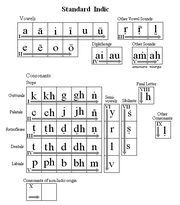
Lomafanu
Lōmāfānu or Loamaafaanu, also known by the Sanskrit name Sasanam, are Maldivian texts in the form of copper plates on which inscriptions have been added. The oldest of these plates dates from the twelfth century AD....
(copper plate grants) of the 12th and 13th centuries and in inscriptions on coral stone (hirigā) dating back from the Maldive Buddhist period. Two of the few copper plate documents that have been preserved are from Haddhunmathi Atoll
Haddhunmathi Atoll
Haddhunmathi or Haddummati Atoll is an administrative division of the Maldives. It corresponds to the natural atoll of the same name.It is mostly rimmed by barrier reefs, the broadest of which are topped by islands...
.
The oldest inscription found in the Maldives to date is an inscription on a coral
Coral
Corals are marine animals in class Anthozoa of phylum Cnidaria typically living in compact colonies of many identical individual "polyps". The group includes the important reef builders that inhabit tropical oceans and secrete calcium carbonate to form a hard skeleton.A coral "head" is a colony of...
stone found at an archaeological site on Landhū Island
Landhoo (Noonu Atoll)
Landhoo is one of the inhabited islands of Southern Miladhunmadulhu Atoll, administrative code Noonu Atoll.-Archaeology:...
in Southern Miladhunmadulu Atoll, where there are important Buddhist archaeological remains including a large stupa
Stupa
A stupa is a mound-like structure containing Buddhist relics, typically the remains of Buddha, used by Buddhists as a place of worship....
. The Landhū inscription is estimated to be from 8th century A.D. Even though long before that time Maldivian Buddhist monks had been writing and reading manuscripts in their language, older documents have not yet been discovered.
The reason why even at that time the local script was known as "Divehi Akuru" by Maldivians was because another non-Maldivian script was used in the country. This was a Devanagari
Devanagari
Devanagari |deva]]" and "nāgarī" ), also called Nagari , is an abugida alphabet of India and Nepal...
script related to the form used by Bengali
Bengali language
Bengali or Bangla is an eastern Indo-Aryan language. It is native to the region of eastern South Asia known as Bengal, which comprises present day Bangladesh, the Indian state of West Bengal, and parts of the Indian states of Tripura and Assam. It is written with the Bengali script...
and it had a ceremonial value. The oldest paleographically-datable inscription found in the Maldives is a Prakrit
Prakrit
Prakrit is the name for a group of Middle Indic, Indo-Aryan languages, derived from Old Indic dialects. The word itself has a flexible definition, being defined sometimes as, "original, natural, artless, normal, ordinary, usual", or "vernacular", in contrast to the literary and religious...
inscription of Vajrayana
Vajrayana
Vajrayāna Buddhism is also known as Tantric Buddhism, Tantrayāna, Mantrayāna, Secret Mantra, Esoteric Buddhism and the Diamond Vehicle...
Buddhism
Buddhism
Buddhism is a religion and philosophy encompassing a variety of traditions, beliefs and practices, largely based on teachings attributed to Siddhartha Gautama, commonly known as the Buddha . The Buddha lived and taught in the northeastern Indian subcontinent some time between the 6th and 4th...
dating back to the 9th or 10th century AD This inscription is written in an early form of the Nagari script.
Thus the name "Divehi Akuru" was used historically by Maldivians to distinguish their own writing system from foreign scripts. Foreign scripts were learned and introduced at that time when Maldivian monks visited the Buddhist learning centers of Nalanda
Nalanda
Nālandā is the name of an ancient center of higher learning in Bihar, India.The site of Nalanda is located in the Indian state of Bihar, about 55 miles south east of Patna, and was a Buddhist center of learning from the fifth or sixth century CE to 1197 CE. It has been called "one of the...
and Vikramaśīla University.
Latter Divehi or "Dives Akuru"
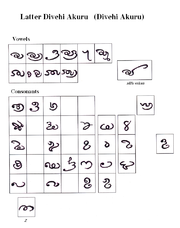
Islam in the Maldives
Islam is the state religion of Maldives, and adherence to it is legally required of citizens by a revision of the constitution in 2008: Article 9, Section D states that a non-Muslim may not become a citizen of the Maldives.-Prominence of Islam:...
. It was still used in some atolls in the South Maldives as the main script until around 70 years ago. Since then it is rarely used, not even having a ceremonial role in scrolls of coats-of-arms or badges of government entities and associations, where Arabic is favoured.
This script can be found on gravestones, old grants in paper and wood, and in some monuments, including the stone base of the pillars supporting the main structure of the ancient Friday Mosque in Malé
Malé
Malé , is the capital and most populous city in the Republic of Maldives. It is located at the southern edge of North Malé Atoll . It is also one of the Administrative divisions of the Maldives. Traditionally it was the King's Island, from where the ancient Maldive Royal dynasties ruled and where...
.
British researcher H.C.P. Bell obtained an astrology book written in Divehi Akuru in Addu Atoll
Addu Atoll
Addu City is a city in Maldives consisting of the inhabited islands of the southernmost atoll of the archipelago....
, in the south of Maldives, during one of his trips. This book is now kept in the National Archives of Sri Lanka
Sri Lanka
Sri Lanka, officially the Democratic Socialist Republic of Sri Lanka is a country off the southern coast of the Indian subcontinent. Known until 1972 as Ceylon , Sri Lanka is an island surrounded by the Indian Ocean, the Gulf of Mannar and the Palk Strait, and lies in the vicinity of India and the...
in Colombo.
Apparently, the Divehi or Dhivehi script was abandoned in other parts of the Maldives
Maldives
The Maldives , , officially Republic of Maldives , also referred to as the Maldive Islands, is an island nation in the Indian Ocean formed by a double chain of twenty-six atolls oriented north-south off India's Lakshadweep islands, between Minicoy Island and...
in favour of the modern Tāna script about 200 years earlier, perhaps at the beginning of the 18th century. Some modern Maldivian historians want to believe that the Tāna script was introduced a few centuries before that. But the claim that the Tāna letters were devised in the 16th century is not supported by historical documents, for the oldest writing specimens in the Tāna script, interspersed with Arabic, are from the 18th century.
The modern script
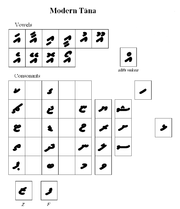
Thaana
Thaana, Taana or Tāna is the modern writing system of the Divehi language spoken in the Maldives. Taana has characteristics of both an abugida and a true alphabet , with consonants derived from indigenous and Arabic numerals, and vowels derived from the vowel diacritics of the Arabic abjad...
is the first Maldivian script written from right to left. It was inspired on numbers. It uses numerals as consonants and adds the diacritical (vowel) marks of the Arabic language.
The first Tāna manuscripts are written in a crude early version of this script called Gabulhi Thaana (incipient Thaana), where the Arabic numerals have not yet been slanted 45 degrees and still look like numbers. Since no ancient writings in Tāna written before the 18th century have been found, it is doubtful that this script could be much older.
The main reason why the Divehi Akuru were abandoned in favour of the Tāna script was owing to the need the learned Maldivians had to include words and sentences in Arabic while writing in the Divehi
Dhivehi language
Maldivian is an Indo-Aryan language predominantly spoken by about 350,000 people in the Maldives where it is the national language. It is also the first language of nearly 10,000 people in the island of Minicoy in the Union territory of Lakshadweep, India where the Mahl dialect of the Maldivian...
language.
The most intriguing fact about the Tāna alphabet is its order (hā, shaviyani, nūnu, rā, bā, etc.). Its sequence doesn’t follow the ancient order of the other Indic scripts (like Sinhala
Sinhala alphabet
The Sinhala alphabet is an abugida used in Sri Lanka to write the official language Sinhala and also sometimes the liturgical languages Pali and Sanskrit...
or Tamil
Tamil language
Tamil is a Dravidian language spoken predominantly by Tamil people of the Indian subcontinent. It has official status in the Indian state of Tamil Nadu and in the Indian union territory of Pondicherry. Tamil is also an official language of Sri Lanka and Singapore...
) or the order of the Arabic alphabet
Arabic alphabet
The Arabic alphabet or Arabic abjad is the Arabic script as it is codified for writing the Arabic language. It is written from right to left, in a cursive style, and includes 28 letters. Because letters usually stand for consonants, it is classified as an abjad.-Consonants:The Arabic alphabet has...
. In fact the order of the Tāna alphabet doesn’t follow any logic at all.
This fact points to a likely esoteric origin of Tāna, namely to a script that was scrambled on purpose in order to keep it secret from average islanders. At their origin the Tāna characters, which are based on Arabic numerals and other symbols, were used in fandita (local magic or sorcery) to write magical spells. Many of these arcane incantations included Arabic quotations, which were written from right to left. Maldivian learned men, who were all well versed in sorcery, eventually saw the advantages of writing in this simplified hidden script. Hence, with the passing of time, Tāna came out of the shadows and was gradually adopted for everyday use.
This script is currently in use as the sole Maldivian writing system. While at their origin documents written in Tāna were full of Arabic words and quotations, the tendency is now to include as little Arabic script as possible, especially since special Thaana letters with dots were introduced to replace Arabic letters. The Thaana script is widely used nowadays by Maldivians both in official and unofficial documents, for the literacy rate of the Maldive society is very high by South Asian standards.
Abolishment of the letter naviyani
Letter naviyaniNaviyani
Letter Naviyani used to be the 19th letter of the Divehi alphabet. This letter's former position in the alphabet was between letters Daviyani and Zaviyani....
ޱ, the retroflex "n" sound common to all Indic languages (Sinhala, Bengali
Bengali language
Bengali or Bangla is an eastern Indo-Aryan language. It is native to the region of eastern South Asia known as Bengal, which comprises present day Bangladesh, the Indian state of West Bengal, and parts of the Indian states of Tripura and Assam. It is written with the Bengali script...
, Hindi
Hindi
Standard Hindi, or more precisely Modern Standard Hindi, also known as Manak Hindi , High Hindi, Nagari Hindi, and Literary Hindi, is a standardized and sanskritized register of the Hindustani language derived from the Khariboli dialect of Delhi...
, etc.), was abolished from official documents in 1950 by Muhammad Amin, the ruler of Maldives. The reason why this particular retroflex sound was abolished and not others like Lhaviyani, Daviyani or Taviyani is not known. Perhaps it was a mere whim of the charismatic Maldivian leader of those times.
Letter Naviyani's former position in the Thaana alphabet was the nineteenth, between letters Daviyani and Zaviyani. It is still seen in reprints of traditional old books like the Bodu Tartheebu. It is also used by people of Addu
Addu Atoll
Addu City is a city in Maldives consisting of the inhabited islands of the southernmost atoll of the archipelago....
and Fuvahmulah when writing songs or poetry in their language variants.
The unique letter of Shaviyani
Letter ShaviyaniSha viyani
Letter Shaviyani is the second letter of the Thaana abugaida- the writing system used in Dhivehi language of the Maldives and Minicoy Island. - Phonological significance :...
( ށޱ - formerly Rhaviyani) is the second letter of the Thaana alphabet
Dhivehi Writing Systems
The Dhivehi or Divehi writing systems are the different scripts used by Maldivians during their history. The early Maldivian scripts fell into the abugida category, while the more recent Taana has characteristics of both an abugida and a true alphabet...
. The Shaviyani sound ([ʂ]) is unique to the Dhivehi language
Dhivehi language
Maldivian is an Indo-Aryan language predominantly spoken by about 350,000 people in the Maldives where it is the national language. It is also the first language of nearly 10,000 people in the island of Minicoy in the Union territory of Lakshadweep, India where the Mahl dialect of the Maldivian...
and is most similar to the cerebral t (ඨ [ʈa]) in Sinhalese. Shaviyani is considered a unique characteristic of the language of the first Maldivian settler still reminiscent in the Dhivehi language today.
The ‘DIVEHI AKURU’ book
In 1959, during Sultan Mohammed Farid’s reign, former Prime Minister (and later President) Ibrahim NasirIbrahim Nasir
Ibrahim Nasir Rannabandeyri Kilegefan , KCMG, NGIV was a Maldivian politician who served as Prime Minister of the Maldives under Sultan Muhammad Fareed Didi from 1957 to 1968 and succeeded him to become the first President of the Second Republic from...
expressed a wish to have a book written about the former Maldivian script which by that time was largely ignored by Maldivians. Thus, he contacted As-Sayyid Bodufenvalhuge Sidi
Bodufenvalhuge Sidi
Bodufenvalhuge Sidi or Assayyidhu Bodufenvalhugey Seedhee , was a much-celebrated Maldivian intellectual and writer.Bodufenvalhuge Sidi, born on 19 May 1888 as Hussain el-Hussaini, was Bodufenvalhuge Don Manike and Mohamed Kuda Sidi’s son....
, an eminent Maldivian scholar, who swiftly obliged.
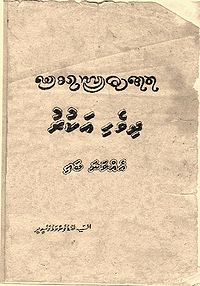
As-Sayyid Bodufenvalhuge Sidi was one of the very few Maldivian people of modern times who understood the now-forgotten ancient Divehi letters in which parts of royal grants, warrants and deeds were written. He learnt this ancient script in Addu Atoll
Addu Atoll
Addu City is a city in Maldives consisting of the inhabited islands of the southernmost atoll of the archipelago....
. Until early in the twentieth century, all government correspondence to and from Addu Atoll was written using these ancient Divehi letters.
The last chapter of this book shows a text where the Divehi Akuru are coming along with Arabic script. As the reader acquainted with Maldivian writing can see, this book is Volume 1 (evvana bai). Perhaps Bodufenvalhuge Sidi had the intention of publishing a second, or perhaps even a third volume on the subject. But unfortunately this important Maldivian learned man died before being able to do so.
Even though H.C.P. Bell did a very careful and thorough research on the Maldivian documents, Prime Minister Ibrahim Nasir
Ibrahim Nasir
Ibrahim Nasir Rannabandeyri Kilegefan , KCMG, NGIV was a Maldivian politician who served as Prime Minister of the Maldives under Sultan Muhammad Fareed Didi from 1957 to 1968 and succeeded him to become the first President of the Second Republic from...
’s intention was to have a book on the ancient script of the Maldives written by a Maldivian. Prime Minister Nasir's request to Bodufenvalhuge Sidi was done in order to clarify H.C.P. Bell’s misinterpretations, no matter how few. A staunch Maldivian nationalist, Nasir took this issue as a matter of national pride.
Present day members of Maldivian cultural institutions are aware of the lacunae in Bell's research and of Bodufenvalhuge Sidi's valuable contribution to mend matters, but little has been done to correct those inaccuracies. Still, H.C.P. Bell’s broad and valuable contributions to the study of the Maldivian language and scripts should not be underestimated.
Latin transliteration of Divehi
Towards the mid 1970s, during President Ibrahim Nasir's tenure, TelexTelegraphy
Telegraphy is the long-distance transmission of messages via some form of signalling technology. Telegraphy requires messages to be converted to a code which is known to both sender and receiver...
machines were introduced by the Maldivian Government in the local administration. The new telex equipment was viewed as a great progress, however the local Tāna script was deemed to be an obstacle because messages on the telex machines
Teleprinter
A teleprinter is a electromechanical typewriter that can be used to communicate typed messages from point to point and point to multipoint over a variety of communication channels that range from a simple electrical connection, such as a pair of wires, to the use of radio and microwave as the...
could only be written in the Latin script
Malé Latin
Dhivehi Latin or Maldivian Latin, known colloquially as Malé Latin or Nasiri Latin, is a Latin Dhivehi alphabet briefly mandated in the Maldives from 1976, but the country reverted to the native Tāna and Arabic alphabets in 1978...
.
Following this, "Dhivehi Letin", an official Latin transliteration was swiftly approved by the Maldive government in 1976 and was quickly implemented by the administration. Booklets were printed and dispatched to all Atoll and Island Offices, as well as schools and merchant liners. This was seen by many as the demise of the Tāna script.
Clarence Maloney, the American anthropologist who was in the Maldives at the time of the change, lamented the crude inconsistencies of the "Dhivehi Letin" and wondered why the modern IAST Standard Indic transliteration had not been considered. Standard Indic is a consistent script system that is well adapted to writing practically all languages of South Asia.
The Tāna script was reinstated by President Maumoon shortly after he took power in 1978. There was widespread relief in certain places, especially rural areas, where the introduction of Latin had been regarded as a preliminary to the introduction of infidel mores. However, the substandard Latin transcription of 1976 continues to be widely used.
Devanagari script for Mahal
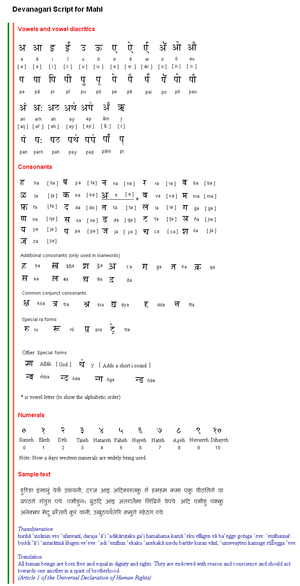
Minicoy
Minicoy, locally known as Maliku is a census town in the Indian union territory of Lakshadweep and was formerly a part of Maldive Islands.-Etymology:...
in Union territory of Lakshadweep
Lakshadweep
Lakshadweep , formerly known as the Laccadive, Minicoy, and Amindivi Islands, is a group of islands in the Laccadive Sea, 200 to 440 km off the coast of the South West Indian state of Kerala...
, India
India
India , officially the Republic of India , is a country in South Asia. It is the seventh-largest country by geographical area, the second-most populous country with over 1.2 billion people, and the most populous democracy in the world...
is also written mainly using the Tāna alphabet, around the 1950s a Devanagari script was modified to write the Language. However, the script is rarely used and never preferred over Tāna by the locals in their writings.

